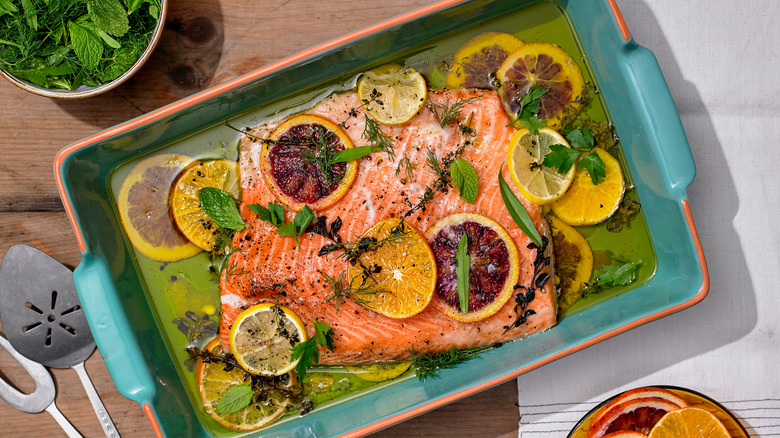The Simple Temperature Mistake That Could Be Ruining Your Salmon
We've all been stuck at a dinner gathering, quietly laboring through Aunt Meredith's dry and lifeless salmon fillet, ruthlessly cooked to the point of oblivion. In fact, there is little as disappointing or wasteful as a mismanaged cut of meat. Often, overcooked steak is seen as the ultimate sign of blasphemy — and we're here to say the same could be true for rich and flaky cuts of salmon. After all, the poor salmon didn't do anything to you. It doesn't deserve to die for an embarrassing, joyless meal.
Fortunately, there are a few fool-proof ways to cook your salmon so that it is perfect every time. And when we say "perfect," we mean the platonic ideal that all fillets should strive to become — with crunchy, crispy skin, just-rendered fat, and juicy, well-seasoned flesh. When you know how to properly cook the cut of meat you are working with, seasoning becomes easy. Salmon partners brilliantly with bright, acidic flavors such as yogurt or citrus, herbs, ginger, scallions or shallots, various fats like sesame oil ... the list goes on.
However you like to complement the naturally unctuous flavors inherent in a salmon fillet, by avoiding this simple temperature mistake, you can end up with a mouthwatering main dish perfect for any occasion.
How to get perfectly cooked, crispy-skinned salmon every time
The first step in cooking a superior slab of salmon comes with choosing the cut of fish. Look for a fillet with the skin on and to end to end up with crispy skin, place your seasoned fillet skin side down when cooking (via Food & Wine). If you really want to ensure crispy skin, Bon Appétit suggests placing your fillet in the refrigerator skin side up to dry out for about an hour prior to cooking.
When it comes to treating your fish right, temperature is everything. While crispy skin relies on relatively high heat in order to get a desirable sear, this is best applied during the initial skin-browning process — not for the entirety of the cooking time. In fact, Food & Wine says that applying high heat throughout the process is one of the most critical mistakes a home cook can make. A perfectly-cooked salmon fillet will look "translucent," according Once Upon a Chef.
When it comes to salmon fundamentals, remember to be liberal with your application of fat — both for flavor and preventing the fillet from sticking. To get the best of both worlds (i.e. crispy skin and melt-in-the-mouth flesh), sear your fillet skin side down on high heat until brown before transferring to a 200-degree Fahrenheit oven for around 40 minutes (via The Endless Meal). And, if you really care, leave the fillet uncovered.

